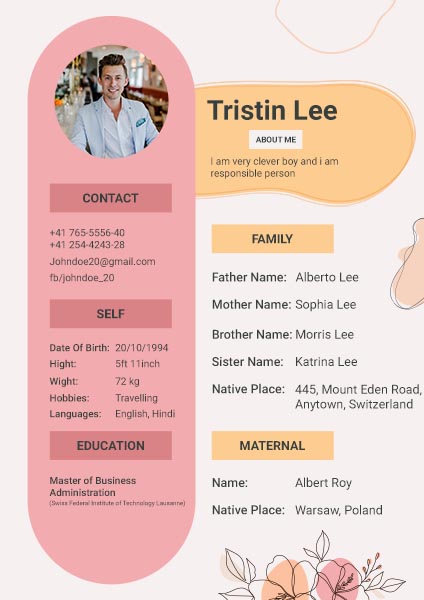Creating a biodata for marriage is an essential step in the matrimonial process, especially in cultures where arranged marriages are prevalent. This document serves as a personal profile that provides potential partners and their families with crucial information about an individual. In this article, we will delve into the intricacies of biodata for marriage, discussing its importance, structure, content, and tips for making it stand out.
Understanding Biodata for Marriage
Biodata for marriage is more than just a resume; it is a detailed representation of an individual’s life, values, and aspirations. It typically includes personal details such as name, age, height, religion, education, profession, family background, and interests. The purpose of this document is to facilitate compatibility assessments between prospective partners.
The Importance of Biodata in Matrimonial Alliances
-
First Impressions Matter
The biodata serves as the first point of contact between families. A well-structured biodata can create a positive impression and spark interest. -
Facilitates Compatibility Assessment
By providing comprehensive information about oneself and one’s family background, biodata helps in assessing compatibility on various levels—cultural, educational, and emotional. -
Saves Time
A detailed biodata can save time during the matchmaking process by allowing families to quickly evaluate potential matches based on shared values and lifestyles. -
Reflects Seriousness
Submitting a thoughtfully prepared biodata indicates seriousness about marriage and respect towards the other party’s time and effort.
Essential Components of Biodata for Marriage
Creating an effective biodata requires careful consideration of several key components:
1. Personal Information
- Name: Full name including any nicknames.
- Age/Date of Birth: Age should be clearly stated along with the date of birth.
- Height: Mention height in feet/inches or centimeters.
- Religion/Caste: Specify your religion and caste if applicable.
- Location: Current city or country of residence.
2. Educational Background
- Degrees Obtained: List all degrees along with institutions attended.
- Special Achievements: Include any honors or received awards during your academic journey.
3. Professional Details
- Current Employment Status: Job title and organization.
- Career Goals: Briefly outline your professional aspirations.
- Income Level (optional): Some may choose to include their salary range.
4. Family Background
- Parents’ Occupation: Brief details about parents’ professions.
- Siblings: Information about brothers/sisters including their marital status.
- Family Values: Describe your family’s cultural values or traditions.
5. Personal Interests & Hobbies
This section allows you to showcase your personality:
- Hobbies: Reading, traveling, cooking etc.
- Interests: Sports, arts, music etc.
6. Expectations from Partner
Clearly outline what you seek in a partner:
- Qualities: Traits like honesty, humor etc.
- Lifestyle Preferences: Career-oriented vs family-oriented etc.
7. Photographs
Including recent photographs can add a personal touch to your biodata:
- Choose clear images that reflect your personality—formal photos are often preferred but casual ones can also be included if they represent you well.
For more information : Raksha Bandhan wishes
Tips for Writing an Effective Biodata for Marriage
-
Be Honest and Authentic
Authenticity is key when creating your biodata; misrepresentation can lead to misunderstandings later on. -
Keep It Concise Yet Informative
Aim for clarity without overwhelming detail; ideally keep it within 1–2 pages. -
Use Positive Language
Frame your experiences positively; focus on strengths rather than weaknesses. -
Proofread Your Document
Spelling or grammatical errors can detract from professionalism; ensure thorough proofreading before sharing it with others. -
Seek Feedback from Trusted Sources
Before finalizing your biodata, consider getting feedback from family members or friends who understand matrimonial expectations well. -
Customize According to Audience
Tailor your biodata based on whom you are presenting it to; different families may have varying expectations regarding format or content emphasis. -
Include Contact Information (if appropriate)
If you are comfortable doing so, include contact details at the end of the document for follow-up discussions regarding potential matches.
Conclusion
A well-crafted biodata for marriage serves as a vital tool in navigating the complex world of matrimonial alliances. By providing essential information about yourself while reflecting authenticity and positivity through thoughtful presentation, you increase your chances of finding a compatible partner who shares similar values and aspirations. Remember that this document not only represents you but also sets the tone for future interactions with potential partners’ families—so invest time into making it truly reflective of who you are!
